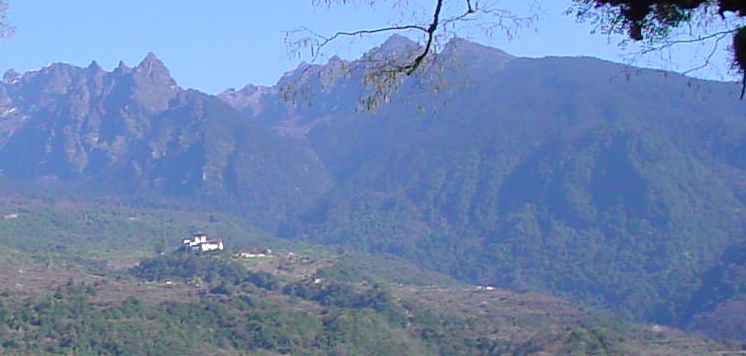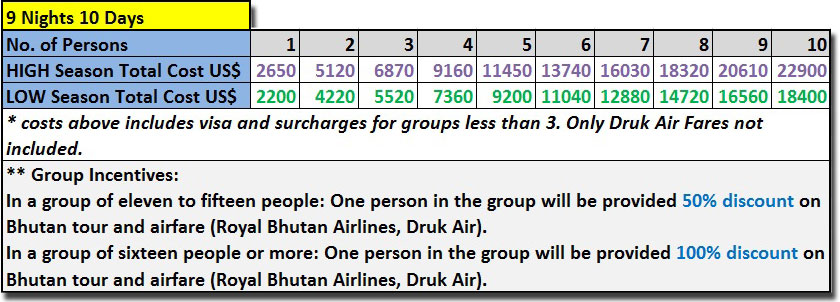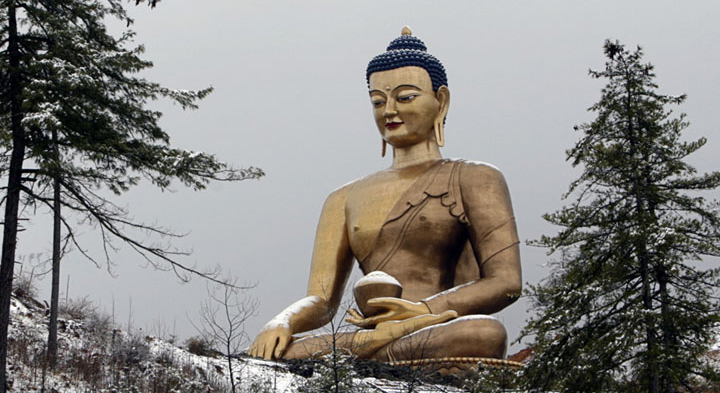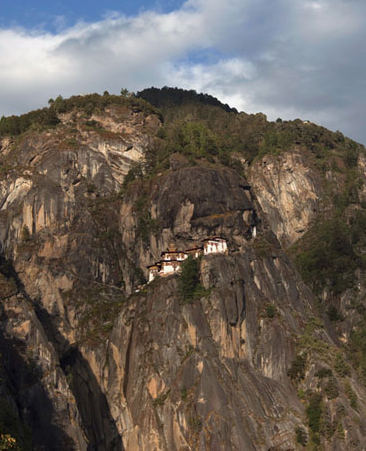
Gasa Hot Springs Trek
- 9 Nights 10 Days
- Western Bhutan

Gasa Dzong can be seen in the distance towards
the bottom left.
Duration: 9 Nights
10 Days (Trek- 4 days)
Package Cost: US$ 2,290 per person (High Season); US$
1,840 per person (Low Season)
High Season- March, April, May, September,
October & November
Low Season- January, February, June, July,
August & December
| Jan | Feb | Mar | Apr | May | Jun | July | Aug | Sept | Oct | Nov | Dec |
* Prices (costs) quoted are for the entire holiday from start to end.
Max. Elevation:
2,430 m
Highest Camp: 2,250 m
Standard: Easy
Best Seasons: February to March & October to December
Start: Tashithang (Punakha)
Finish: Tashithang (Punakha)
Gasa Hot Springs Trek Summary:
The Gasa Hot Springs Trek is one of the easier treks in Bhutan. Although it is advisable to connect the walking days and walk up to the Tsachhu (Hot Springs). Although the altitude difference between starting and ending point is minimal, the many ups and downs on the way can make it more strenuous than it looks at first sight. However, the relaxation at the Tsachhu and the views and the visit of Gasa Dzong are absolutely rewarding.Itinerary Outline:
Day 01: Arrive Paro
Day 02: Thimphu
Day 03: Thimphu - Punakha - Tashithang
Day 04: Tashithang - Damji - Gasa (Trek Starts)
Day 05: A Day at Gasa Tsachhu
Day 06: Gasa Tsachhu - Geon Damji
Day 07: Geon Damji - Tashithang – Punakha (Trek Ends)
Day 08: Punakha- Thimphu
Day 09: Thimphu - Paro
Day 10: Depart
Detailed Itinerary:
Day 1: Arrive Paro
On arrival at Paro airport you will be received by the Bhutan Rebirth Representative and transferred to Thimphu. Overnight at the Hotel in Thimphu.
Day 2: Thimphu

The statue of the Buddha at Kuenselphodrang Nature Park in Thimphu
After breakfast, at the heart of Thimphu visit the Third King's Memorial Chorten (Stupa) built in 1974 where you will find many devotees circumambulating the Chorten. You will also visit the Changangkha Lhakhang ('Lhakhang' means Temple), the Jungshi Paper factory where they make traditional Bhutanese paper, the National Library that houses the world’s largest book, ancient Buddhist texts and manuscripts and a Painting School famous for traditional thangkha ('thangkha' is a religious painting), Traditional Medicine Institute, Handicrafts Emporium and the Folk Heritage Museum in KawajangsaVisit the Choki Handicrafts shop where Bhutanese textiles and other handicrafts are displayed and can be purchased. The shop is closely linked to the Choki Traditional Art School- many of the goods are produced in the school itself and all proceeds go towards the upkeep of the school and the provision of tuition for the students. Later, visit the Tashichhodzong (seen above)- The ‘Fortress of the Glorious Religion’ houses the Throne Room of His Majesty the King, the Main Secretariat Building and the Central Monk Body.
Day 3: Thimphu - Punakha - Tashithang
Drive to Punakha via Dochula pass (3,100 m), through magnificent forests of rhododendron and magnolia. On clear days you can have a panoramic view of the Eastern Himalayan peaks. Picnic lunch at Punakha by the riverside. Enjoy the view of Punakha Dzong (welcome page of this website), built in 1637 during the time of Shabdrung Ngawang Namgyal. The Dzong is now used as the winter residence of the monk body and administrative centre of the district. After lunch drive on to Tashithang following the Mo Chhu River. Camp at Tashithang 1,600 m.
Day 4: Tashithang - Damji - Gasa (Trek Starts)
(Camp below the Dzong at an altitude of 2,900 m. Walking time 6-7 hours). The trek starts by the riverside, following a well-made path through semi tropical forests. For flower lovers there are abundant wild orchids here. The day’s walk is fairly gentle climbing up to Damji village at an altitude of 2,250 m, walking time 5/6 hours. After lunch, you will continue walking through sub-tropical forests and villages up to Gasa Tsachhu (Hot Springs). The Tsachhu is a famous place where people from all over the country come to have bath, due to its curative powers. You will walk up to the Dzong in the evening.
Day 5: A Day at Gasa Tsachhu
You can either laze around in the hot springs or take a pack lunch and climb about two hours to visit Gasa village and the Dzong.
Day 6: Gasa Tsachhu - Geon Damji
(Camp. Alt. 2280 m. Distance 21 km. Time
6-7 hours).
After a short climb, the trail winds through the rolling hills and passes
through the pine and oak forests, villages and wheat fields. You will
also see a beautiful view of Gasa Dzong glued to the valley wall, seeming
to float in space.
Day 7: Geon Damji - Tashithang – Punakha (Trek Ends)
The trail descends from the high agricultural benches above the Mochhu ('Chhu' means River) into a lush semi-tropical gorge filled with banana trees, creepers and various tropical vegetation. You will also see monkeys and a few other animals occasionally. Arrive at Tashithang at an altitude of 1700 m after walking 17 km for about 6-7 hours. Your car will be waiting here to transfer you to Punakha. Relax in the Hotel and overnight in Punakha.
 Day
8: Punakha- Thimphu
Day
8: Punakha- Thimphu
Morning, visit the Punakha Dzong the former Capital of Bhutan. The Dzong lies between two rivers known as the Phochhu and Mochhu, which means ‘Male River and Female River’. It was built by Shabdrung Ngawang Namgyal the unifer of Bhutan in 1637 AD and is one of the most important and historical Dzongs in Bhutan. In the Dzong are kept the sacred remains of Pema Lingpa and Shabdrung Ngawang Namgyal and the relic of Rangjung Khasarpani. According to history, the Tibetans were after the Rangjung Khasarpani, a sacred relic that was in possession of the Shabdrung. It is said that the Shabdrung outwitted the Tibetans by pretending to throw this relic in the Punakha River and the Tibetans lost hope and withdrew. The Dzong now houses the District Administration office and the winter residence of the state Monastic Body and its Chief Abbot. After lunch, drive to Thimphu. While in Thimphu you will stroll in the town visiting some handicraft shops. Overnight at Hotel in Thimphu.
Day 9: Thimphu - Paro
After breakfast drive to Paro and on arrival, you will check into your Hotel. Then hike to the Tiger's Nest Monastery (right). The hike is about 3 hours to the Monastery. It is said that the 8th century Spiritual Master, Guru Rinpoche, arrived here on the back of a Tigress, meditated in the cave for three months. Hike back to Paro in the evening. Evening stroll freely in Paro town. Overnight Hotel in Paro.
Day 10: Depart
Drive to the airport. Our representative will bid you farewell and hope to see you again soon.
Note: These trekking itineraries have been designed based on past experiences of visitors to Bhutan and what they experienced about various trek routes. They show the actual duration of the trek only. They can be combined with other cultural tours or treks. The treks are such that you can gain the maximum out of this experience without exhausting you. The treks may depend on seasons. However, these readymade itineraries may not be convenient for some visitors. That is why we would be very happy to, together with you, design a new itinerary to fit all criteria and interests as desired by you. Please write to us with your special interests and/or requirements at bhutanrebirth@gmail.com.
| |
BACK TO TREKS MAIN PAGE |
